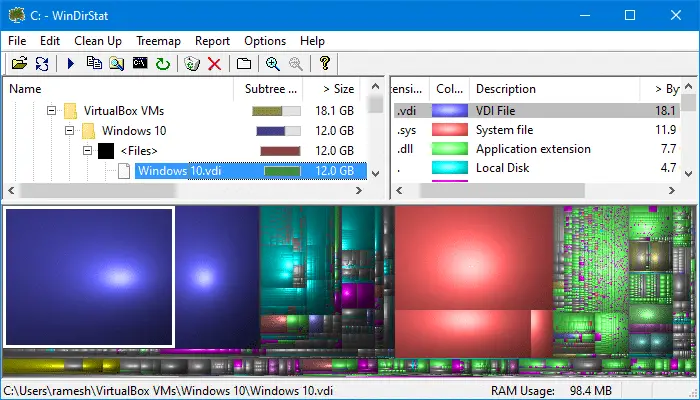
- #How to use windirstat to clean up update#
- #How to use windirstat to clean up upgrade#
- #How to use windirstat to clean up full#
- #How to use windirstat to clean up windows 10#
- #How to use windirstat to clean up Pc#
Obviously, removing these files makes it harder to recover data in case of an issue. Once that's done, look for the Previous Windows installation(s) and delete it using this tool. It won't delete if you try to go through the File Explorer, so type Disk Cleanup into the Start Menu and launch the tool as described earlier.Ĭlick Clean up system files at the bottom of the window and let the utility do another scan. Windows automatically removes this folder a short time after upgrading, but you can remove it yourself if you're crunched for space. It's also possible to open the folder and grab a few stray files if you need. If necessary, you can use this folder to roll back to a previous version of Windows. This folder essentially holds everything that made up your old installation, in case something didn't transfer correctly.
#How to use windirstat to clean up upgrade#
Whenever you upgrade your version of Windows, the system keeps a copy of your prior files called Windows.old. On this menu, you can change the maximum size of the bin, or even choose Don't move files to the Recycle Bin. To tweak the way the Recycle Bin works, click Recycle Bin properties here. On the top Ribbon's Recycle Bin Tools tab, you'll see buttons to Empty Recycle Bin and Restore all items at once. Right-click on individual items and choose Delete to permanently erase them, or choose Restore to send the file back to its original location. Once here, you'll see everything you've deleted recently. If you don't see that, type shell:RecycleBinFolder into File Explorer's navigation bar. You can access the Recycle Bin through the shortcut on your desktop. It's easy to forget that gigabytes of old data can sit in your Recycle Bin. While this might be obvious to you, we're including it in case some aren't aware. This is a special place where deleted files are kept until you permanently delete or restore them. The Recycle Bin is a special folder-while it appears under your C:\ drive, this is protected by Windows and you don't need to access it that way. Whenever you delete a file on your system, Windows sends it to the Recycle Bin. However, this isn't much of a loss, as this feature is known to cause slow boot times and other problems. Note that disabling hibernate mode will also prevent your computer from using fast startup in Windows 10. Windows should delete hiberfil.sys on its own when you do this feel free to delete it after if not. That's all it takes to disable hibernation. Type the following command to disable hibernation: powercfg.exe /hibernate off Right-click on the Start button or press Win + X, then open a Command Prompt (Admin) or Windows PowerShell (Admin) window from the resulting menu. Note that you shouldn't just delete hiberfil.sys, as Windows will recreate it again.

If you don't use hibernation and want to disable it, you can easily do so via the Command Prompt. Depending on your hard drive size, the hibernation file is likely several gigabytes or more. Of course, this takes up space, which is what the hibernation file is for. You can remove the battery from your laptop and stay in hibernation for a week, then start back up and pick up right where you left off.
#How to use windirstat to clean up Pc#
Hibernation mode on your PC is similar to sleep mode, except the system saves all your open work to the storage drive and then shuts down.
#How to use windirstat to clean up windows 10#
Now, let's look at what you can delete from Windows 10 safely.
#How to use windirstat to clean up update#
Windows upgrade log files: Similarly, these are data files that Windows Update keeps to help you dig into problems around upgrades or installations.


These are safe to delete in most cases, but you should keep them for troubleshooting if you run into update-related issues.
#How to use windirstat to clean up full#
This isn't a full guide to the Disk Cleanup tool, so we're not going to look at every option it offers.


 0 kommentar(er)
0 kommentar(er)
